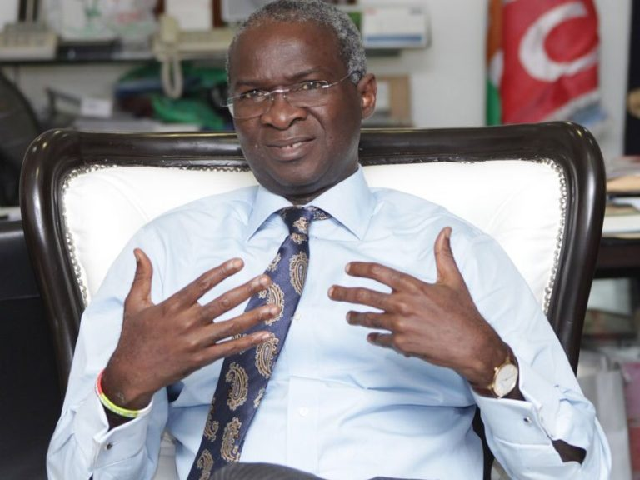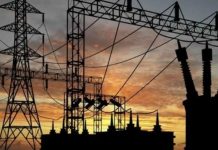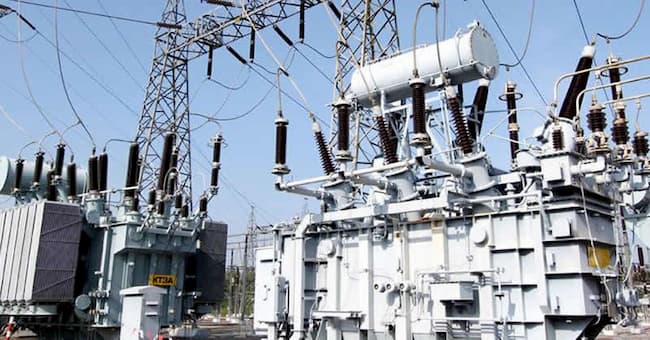Babatunde Fashola, Minster for Power, Works and Housing, says the Federal Government’s road map for solving the country’s power crises is to attain incremental power wherever it can be found, thus achieving steady power and ensuring uninterrupted power supply. Fashola stated this while delivering a lecture titled: ‘Nigeria’s electricity challenges, a road map for change. See the speech below.
Ladies and Gentleman,
When I assumed office as minister, maybe I should have done some of the more traditional things.
To tell you that your generators will disappear in one year or to tell you how many Thousands of Megawatts you will get in how many months.
I am sure these would have grabbed a lot of headlines and attracted front page coverage.
But history tells us clearly that we have done all these before and we still do not have enough power.
I could also have started by telling you how many people will be probed for all the money spent on power.
But those of you who choose not to forget will remember that we have probed almost everybody and every institution concerned with power in the past and we still do not have enough power.
I could also have started by announcing or recommending that the privatization process should be cancelled.
I know first that cancellation of contracts is not a good signal to send to investors; even if it grabs the headlines it will be for the wrong reasons.
History also tells us that we have revoked, cancelled or reversed previous privatization initiatives with refineries before and we still haven’t overcome the problem.
I have chosen to start my discussion this way because my topic is “Nigeria’s Electricity Challenge: A roadmap for change.”
I believe we must depart from these routes we have previously travelled if we must overcome the electricity challenge and I am optimistic that we can.
In charting the roadmap for change, I am of the view that we must first tell ourselves what is wrong.
The simplest way I can put it is to say that we do not have enough power.
Since 1950 when the Electricity Corporation of Nigeria (ECN), the predecessor of NEPA and PHCN, was created, the maximum energy we have generated stands at 5074 MW was achieved in February 2016 this year.
This is not enough to power a country whose population is in the hundreds of millions and is still growing.
So in answer to the big question, ‘What is the roadmap?’ I say it is getting “incremental power”, in a way that every Megawatt of power must be harnessed and made available to our people.
From “incremental power” we should maybe then seek to deliver “steady power” and from then go on to “uninterrupted power.”
In the quest for incremental power, we must not overlook the things we have done poorly in the past.
They range from improperly erected distribution poles, characterized by poor quality materials, poor workmanship, poor standards by local and foreign contractors who were employed to deliver the services and did not give us value for money.
We must look at cable theft, vandalization of pipelines and transformers, power theft by consumers who use energy without meters or consumers who pay unscrupulous people who help bypass meters.
We must look at court disputes, and protests and those who attack the efficiency of the power system in order to resolve grievances.
We must resolve that these will not happen again in our road map for change.
Incremental Power
In our road map to incremental power we are looking at what we have and what we can get out of them.
We have 26 (TWENTY-SIX) power plants (including the AES plant) , 3 (THREE) of the plants are powered by water, the Hydro power plants in Jebba, Kainji and Shiroro.
The remainder are powered by gas.
The total number of turbines which should actually generate power from 25 (TWENTY-FIVE) power plants (excluding AES) is 140 turbines. ( Installed capacity of 12,341MW).
At the best of times only about 78 turbines are generating power which gave us our peak of 5074 MW.
The problems have been identified as either damaged, unmaintained or unserviced turbines in the Hydro power plants, and in the cases of gas plants, it is largely non-availability of gas, coupled with lack of maintenance.
I will illustrate with a few examples.
The Jebba Hydro power plant was commissioned in 1985 by President Buhari with 6 (SIX) turbines to provide 540MW of power; from water energy from Kainji.
In the briefing I received on assumption of office, the turbines were to be overhauled as scheduled maintenance once every 5-6 years. This was never done for 28 years, until it was handed over in 2013, in the aftermath of the privatization.
The first overhaul has now been completed and more will be undertaken. This is incremental power.
In the report recently submitted to my office by the concessionaire of Jebba and Kainji, the total available capacity of the 2 (TWO) plants is 482 MW and 340 MW respectively totaling 822 MW and they plan to get to 1338 MW. This is incremental power.
Egbin Power plant in Ikorodu was delivered in 1985 during the tenure of President Babangida. It had 6 (SIX) turbines with total capacity of 1,320 MW.
When it was handed over in 2013, it had only 2 (Two) functional turbines and just about 400 MW generating capacity.
I was at the plant in December 2015, to switch on Turbine 6, which means all the 6 (SIX) turbines have been restored. This is incremental power.
But these are just examples of the maintenance and technical challenges we grapple with daily in the Government from the President, to the Vice-President, and the Ministry who seek to manage the men and women.
Let me share with you some of the human and administrative challenges, relating to incremental power.
You might recall the announcement of an alleged “commissioning” of a power plant in Edo state by the last administration during the election campaign. This was the Azura power project meant to deliver 450 Megawatts. In reality what took place was only the turning of the sod.
The main activity which were Government securities and guarantees to enable the financing of the project were never issued. This was delayed for about a year.
It was the Buhari administration that prioritized this, resolved it, and work has now started with 422 workers on site and estimated completion date of December 2018. This is the road to incremental power.
You might also recall the Aba Power plant initiated by Prof. Barth Nnaji to generate140 MW and ring fence Aba for dedicated power long before he was ever appointed minister.
He had an agreement which assured him that the plant will never be sold in the event of privatization. This agreement was given by the Government of Nigeria
The same Government later made another agreement, ignoring the original one, and sold Enugu DisCo to a new owner which included Aba Power.
In the event, none of the parties were to blame.
They had legitimate contracts which were conflicting and issued by the same government.
Instead of spending their energy and resources completing the power plants and delivering electricity, they were forced to spend their resources and energy seeking to untie themselves from the problems created by government since 2013.
This government has waded into the matter, and, through the Vice President, directed our ministry to facilitate reconciliation, and with the cooperation of the parties, their sense of patriotism, we got the parties out-of-court in a settlement three years after.
We are now formalizing their papers so that they can operate independently and collaborate to supply power to Aba and Enugu Distribution that covers most of the East instead of fighting in court.
Solving the problems of yesterday is the road to incremental power.
Other examples are Zungeru Power Plant, meant to deliver 700 MW in Niger state but which was held up in court for several years.
Although the project is now three years behind, the dispute has been resolved, parties are out of court, over 800 workers are back on site and this should deliver incremental power.
There is also the 215 MW plant in Kaduna which was designed to use gas, which is several hundred kilometers away from gas sources. While we are working to consider alternative and sustainable fuel supply, we have resolved never to site power plants far away from their fuel source.
To achieve this, we are working round-the-clock within the ministry, and with other ministries like Solid Minerals, Water Resources and Ministry of Environment, to deliver an energy mix that will assist power production, investors and all stakeholders on how to site solar power in the North, Hydro Power in the North and North-Central, Coal in the North Central and South East and gas in the South-West and South-South.
This is our roadmap to incremental power, because it not only makes the power cheaper, if the fuel is nearer, but it makes it easier to plan and execute transmission plan, to ensure the power is evacuated and distributed.
Other imminent power sources are the 40MW Kasimbilla power plant, the Katsina 10 MW wind and the 222 MW Gbarain plant in Bayelsa State.
There are also those who just require gas to operate and deliver full power such as the AES 240 MW plant in Lagos, the Geregu I and II plants in Kogi state where 4 (FOUR) turbines of 115 MW each simply do not have gas, the Omotosho and Olorunsogo Power Plants where only 3 turbines out of 12 turbines are working, and with the supply of gas we can increase power from the present 160MW to over 600MW.
This is the road map for incremental power.
There is also the plan for Rural Electricity, which should have been completed by law since 2006 but which we inherited and will complete by June this year.
This will detail out the plan to supply power to many of our vulnerable people who live in Rural Areas.
While this is going on, we have about 2,100 Rural projects, mainly constituency projects that were not completed for our budget in 2016 with a view to completing.
Ladies and Gentlemen, in delivering power, we do not act alone.
We need to collaborate with the Ministry of Petroleum Resources to provide gas, the Ministry of Water Resources to provide access to water from the dams and River basins for hydropower, and the Ministry of Solid Minerals for Coal data to assist in reviving some coal power initiatives.
Of course the Ministry of Environment is our regulator to ensure that our mix of power is clean enough not to damage the environment or hurt our people.
Let me restate again that we are not only working together, we are in regular communication and meetings.
The Honorable Minister of State for Petroleum has promised to accelerate the repairs of the damaged Forcados pipeline and restore us to 5000 MW hopefully in June.
The Vice President was also a visitor to the site to encourage prompt completion of the repair works.
In addition, the Ministry of petroleum is working to increase supply to those plants I mentioned: AES, Olorunsogo, Omotosho and Geregu to mention a few.
The Ministry of Water Resources is providing us with data of many dams and water sources across Nigeria that have fallen into disuse and neglect, all of which are capable of delivering some form of power, from the North to the South – Tiga, Challawa, Oyan and Ikere Dams are some examples that readily come to mind.
We have resolved to compile these data, the current photographs of the sites, the statements of requirements for civil Works, electrical and mechanical works, transmission needs and also the immediate and contiguous population as an investment guide to those who seek to take all the opportunities there.
The Ministry of Solid Minerals has provided available data on the prolific coal deposits that can support coal power initiatives, and at the instigation of the Ministry of Environment with their collaboration, we have resolved the framework for ultimately licensing over a dozen prospectors to generate over 1000 MW of solar energy.
As far as generation of more power is concerned, it is clear to us what we must do. It is clear to us how we must do it and it is clear to us how it must be done.
If generating power was the only problem, then the challenges might be easier.
Transmission
However, there is the challenge of transmission, which is the transportation of the power from the generation plants, to the distribution companies who then take it to the homes, offices, factories etc.
This work is done by the Transmission Company of Nigeria (TCN) which was not privatized.
They transport power by building transmission towers and stringing electricity cables, which we call high tension wires here, and installing Transmission, Transformers and so on.
Today they can only transport 5000 MW. That is all we have done since 1950. We must do more and we are on the way.
There are currently about 126 projects awarded for this purpose but with all sorts of problems.
About 907 containers of various equipment imported in the ports, paid for, have been abandoned with demurrage, port charges and all sorts of costs by contractors who have deserted their contracts.
Approvals have been given by Mr. President for their release, we have met with Customs, the shippers, the warehouse owners and operators all of whom have shown an inspiring sense of patriotism to release their containers. These meetings are being chaired by the Vice President.
The containers, expectedly contain all sorts of equipment , which hopefully when recovered will help solve some of our transmission problems.
The related challenge which we are working on is the logistics of warehousing, transportation, inventory and matters related thereto, so that the problem is not transferred from the port to an inland storage. This is part of our roadmap to incremental power. To Transport the power that we plan to produce.
Of course out of the 126 difficult existing contracts plagued by court cases, compensation disputes, way leave challenges, which I mentioned, we have identified 47 which are prepared for completion this year through the 2016 budget. This is the roadmap to incremental power.
But in addition to this immediate plan, TCN has expressed a desire to increase transmission capacity from 5000 MW to 7000 MW, 10,000 MW to 13,000 MW to 16,000 MW and 20,000 MW over 5(FIVE) years from this year.
We have demanded and there are now working to provide us with an implementation plan for each stage; including the detail quantities, design, way leave, cost and everything that will facilitate efficient project implementation
We are also looking at technical possibilities that support the decentralization of the grid while keeping them interconnected.
This will help us take up offers of private investment that ensures that investors can ring fence and collect revenues wheeling charges for the power they help to transmit or transport.
Ladies and gentlemen, this may sound long, but I assure you it is only a summary.
I will now attempt to deal with steady power and uninterrupted power.
Steady Power
While I am optimistic about our plans for incremental power, it is steady power that takes us closer to our goal.
Power cannot be steady unless is is enough. Not only must it be enough, we must create excess capacity. The necessity for excess capacity is discernible from what I have said about the need for maintenance repairs and replacements in places like Kainji, Jebba and other plants.
Powerplants and turbines are not different from our generators at home. If you have only one and it needs to be fixed, it cannot produce power during repairs.
What other countries with steady power do, is to have more than enough, so that while they repair damaged, broken or aging ones, they switch to reserves or excess capacity.
That is what we must do.
Our roadmap to steady power must include the construction and delivery of the Mambilla Hydro power plant in Taraba state.
This project has been in conception since 1982. It has suffered from court delays. But it sits very well with the energy mix that I spoke about earlier. It will be the single largest power plant with over 3000 MW in one place and it potentially takes us close to steady power.
I recently read reports claiming that Mambilla hydropower plant is “stalled.”
Nothing can be further from the truth.
To stall means to stop. Mambilla has not started so you cannot stop what has not started.
We have opened discussions with the Governor of Taraba state, Governor Dickson Ishaku, who incidentally was once a Minister of State for Power. The first thing to do is to acquire the land and deal with compensation issues, which the Governor has promised to deal with.
The next step is to create an earth road to the site to enable more tests of soil and related issues to take place.
The feasibility study has been done and so too the Environmental Impact Assessment.
We move one day at a time closer to starting Mambilla.
But while we’re at it Mambila alone , may not give us steady power. We must know how many we are, so that we can meet the per capita demand of each citizen for power supply.
Without the data, which should come from the next census exercise, the roadmap to steady power is further down the road.
In our quest for steady power, we have also sent letters to local Federal universities as a start to conduct their energy audits and supply results to us and enable us determine their energy needs and hopefully provide dedicated power to these learning institutions and affiliate teaching hospitals.
This way we will be impacting education and healthcare.
We are similarly reviewing data collected by Nigerian Electricity Regulatory Commission (NERC) in respect of industries and factories with the hope of facilitating similar solutions.
These are some of the elements of our roadmap to stable power. They involve the use of Dedicated and Embedded power on a willing buyer, willing seller basis, which is one of the initiatives of the new Tariff.
Of course our monthly meeting which moves from state to state, power location to power location has held unfailingly since January 2016, from Abuja, to Lagos, to Enugu and Calabar and at each meeting we are resolving problems with all the stakeholders from gas, to generation, transmission and distribution in attendance.
At each meeting we are reviewing the progress report of each DisCo for metering and holding them to the implementation of their own metering plan. Sooner rather than later, we will resolve the metering gap.
Ladies and gentlemen, the roadmap to steady power also requires that reportage of power issues should be accurate.
One of the recent inaccurate reports related to CAPMI, the Credit Advance Payment Metering Initiative ,was that I had scrapped it . This is not correct.
What is correct is that since the DisCos now have a market tariff it is their responsibility to find meters as a basis for collection. I think it is unfair to collect money for meters and not supply it within the agreed time.
The correct Resolution passed at our meeting in Enugu was that DisCos should now fund the supply of meters and wind down the Credit Advance programme gradually, so that the burden of funding meters is not perpetually placed on consumers.
The responsibility of Consumers is to pay their Bills for energy they consume not to finance meters.
Our March 2016 monthly meeting further resolved that where DisCos have collected money, they should supply the meters and stop collecting more money; instead they should use their resources to provide meters.
One of the objectives of the monthly meeting, apart from solving problems, is to issue accurate information signed by all stakeholders present, about development in the power sector.
I will now quickly move to summarizing our roadmap to uninterrupted power.
Uninterrupted Power
This has a lot more to do with our people than with our service providers.
The first thing is sustainability of the sector, particularly financial sustainability. Everybody who provides service must also be paid , so that they can continue to do so.
This is what NBET, the Bulk Trader, is trying to achieve with the Bond that guarantees payment to all, even if one player defaults.
It also requires all of us to pay our bills especially Government consumers.
But more importantly we must conserve energy.
In my recent travels to parts of Nigeria, I observed houses, shops, canteens with external bulbs lit up during the day. This is waste. It will impede our roadmap to uninterrupted power.
Nothing can ever be enough if we waste it.
The whole world is moving towards energy friendly homes, where houses are built to use the rays of the sun to light up a home during the day.
There are many homes, offices, factories etc. that have been so poorly built that you cannot operate in them during the day without switching on a light bulb. This is anti-conservation and we must depart from it.
There is a global surge towards energy saving bulbs, televisions and electrical appliances that switch themselves off or switch to standby mode when not in use. These are global best practices for conservation. Those who have more power supply than us are embracing them and we must not be left behind.
There are public facilities in hotels, hospitals offices where toilets and similar facilities switch off power when nobody is there. I believe they use motion sensors. We must embrace them.
In our homes, we must put off appliances, that are not in use; and we must teach our children, right from school, to conserve energy. This, ladies and gentlemen, is our roadmap to uninterrupted power.
There are many other things I would like to discuss such as the roles of NERC, NBET, REA, NEMSA, NELMCO, NDPHC and the APT in the Vice President’s office which time prevents me from doing.
But let me also say before I close, that we are developing multi-pronged information channels, programmes, docu-dramas that will help enlighten our people and bring more information in the weeks and months to come.
However, in closing let me say that this Government is committed to improving the power situation.
It is working through many teams and very soon results will manifest.
I am optimistic because of the collaboration of my colleagues, the Ministers in other ministries upon which our success depends.
I am optimistic by the enthusiasm and renewed dedication of all our staff in the ministry and the Honourable Minister of State.
Most importantly, the enthusiasm of our young people makes me believe that we can solve this problem.
Mustapha, the young man who sat next to me on a flight to Abuja from Lagos recently, makes me believe that this can be achieved. He is already a player in the solar business.
Almost one in every five of the young people I encounter is doing something with power.
This is a critical mass that is bigger than the power challenge.
Whenever Nigerian youths sign up for a cause, they have never lost.
From the struggle against colonialism, to the agitation for democracy and lately to the demand for change, the Nigerian youth have been victorious.
In this concerted effort for electrifying Nigeria, I expect no other result but victory.
I will play my part and I hope you will all play yours.
Ladies and gentlemen, this is my attempt to summarize what we have been doing with your time and your resources for the past 5 months and 24 days since our assumption of office in the Ministry of Power, Works and Housing.














